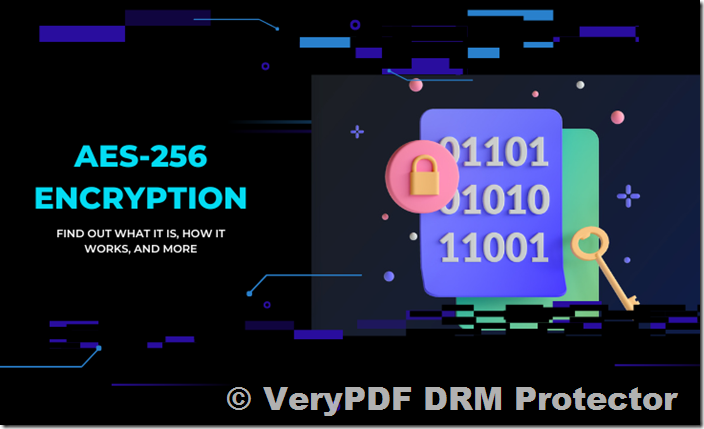Digital Rights Management (DRM) is essential for safeguarding digital content against unauthorized access, duplication, and distribution. DRM systems employ a variety of algorithms and technologies to ensure robust security and control over sensitive data. This article explores the commonly used algorithms in DRM and highlights the VeryPDF DRM Protector, which utilizes the AES-256 encryption algorithm. Additionally, we will delve into the advantages of AES-256 encryption in securing digital content.
Core Algorithms and Technologies in DRM
1. Encryption Algorithms
Encryption forms the backbone of DRM systems, securing content during transmission and storage.
- Symmetric Encryption:
- AES (Advanced Encryption Standard): Widely regarded as the gold standard, AES offers exceptional performance and security.
- DES/3DES: Older algorithms now largely replaced due to vulnerabilities.
- Asymmetric Encryption:
- RSA: Commonly used for encrypting keys that unlock content.
- ECC (Elliptic Curve Cryptography): A modern alternative to RSA that provides similar security with smaller key sizes, making it more efficient.
2. Key Management
Effective key management ensures secure generation, storage, and distribution of encryption keys.
- Key Exchange Protocols:
- Diffie-Hellman Protocol: Securely exchanges encryption keys over untrusted networks.
- TLS/SSL Protocols: Protects key transfers during online communication.
- Key Wrapping: Symmetric keys are encrypted using asymmetric keys for secure transmission.
3. Authentication and Authorization
Verifying the identity of users and devices is crucial for enforcing access controls.
- Hash Algorithms:
- SHA-256/SHA-3: Ensures data integrity and generates digital signatures.
- HMAC: Validates message authenticity and integrity.
- Digital Signatures: Implements RSA or ECC to validate user credentials or content authenticity.
- One-Way Functions: Generates irreversible data fingerprints, such as user credentials or device identifiers.
4. Watermarking
Digital watermarking adds traceable identifiers to content for source tracking.
- Embedded Watermarks: Utilize techniques like Discrete Fourier Transform (DFT) or Discrete Cosine Transform (DCT) to embed identifiers in media files.
- Dynamic Watermarks: Display real-time identifiers, such as user names or session IDs, during content playback.
5. Access Control Mechanisms
DRM systems enforce specific access policies based on user or environmental factors.
- Role-Based Access Control (RBAC): Assigns permissions based on user roles.
- Attribute-Based Access Control (ABAC): Adapts permissions based on device type, location, or time.
6. Hardware-Assisted Security
Modern DRM systems often leverage hardware to enhance security.
- Trusted Execution Environments (TEE): Examples include ARM TrustZone, which securely executes DRM operations.
- Secure Chips: Devices such as Trusted Platform Modules (TPMs) store encryption keys securely.
VeryPDF DRM Protector: Powered by AES-256 Encryption
VeryPDF DRM Protector is a robust DRM solution designed to secure PDF files and sensitive documents. It leverages AES-256 encryption, a symmetric encryption standard known for its unmatched security and efficiency.
What is AES-256 Encryption?
AES-256 is a variant of the Advanced Encryption Standard (AES) that uses a 256-bit key size for encryption. The “256-bit” refers to the length of the encryption key, providing a theoretical key space of \(2^{256}\), making brute-force attacks virtually impossible.
Advantages of AES-256 Encryption
- Unmatched Security: AES-256 is resistant to all known practical attacks, including brute-force, ensuring high levels of data protection. It is approved by the National Institute of Standards and Technology (NIST) and widely used in government and military applications.
- Efficient Performance: AES-256 is optimized for both hardware and software implementation, offering fast encryption and decryption without compromising security.
- Global Compatibility: Supported across a wide range of platforms, including Windows, Linux, macOS, and mobile systems.
- Future-Proof: The vast key space and computational complexity of AES-256 make it resistant to foreseeable advancements in computational power, including quantum computing.
- Versatile Applications: AES-256 can be used for securing data at rest (e.g., stored documents) and data in transit (e.g., during file sharing).
How VeryPDF DRM Protector Secures Your Content
- Data Integrity and Privacy: Your sensitive documents remain inaccessible to unauthorized users.
- Remote Revocation: Administrators can disable access to documents at any time.
- Server-Side Authentication: Ensures that users must communicate with your server to unlock files, adding an additional layer of control.
- Customizable DRM Policies: Tailor access restrictions, such as view-only modes, expiration dates, and device limitations.
Conclusion
For organizations and individuals looking for a secure and customizable DRM solution, the VeryPDF DRM Protector offers the perfect combination of advanced technology and open-source flexibility. Powered by AES-256 encryption, it provides unparalleled protection for your sensitive files while ensuring compliance with modern security standards.
Contact VeryPDF today to learn more about this open-source solution or to discuss how it can be tailored to meet your needs. Visit VeryPDF for additional details or request a demo to experience the power of AES-256 encryption in action.
Protect your files with confidence using VeryPDF DRM Protector!

